- News
- Reviews
- Bikes
- Components
- Bar tape & grips
- Bottom brackets
- Brake & gear cables
- Brake & STI levers
- Brake pads & spares
- Brakes
- Cassettes & freewheels
- Chains
- Chainsets & chainrings
- Derailleurs - front
- Derailleurs - rear
- Forks
- Gear levers & shifters
- Groupsets
- Handlebars & extensions
- Headsets
- Hubs
- Inner tubes
- Pedals
- Quick releases & skewers
- Saddles
- Seatposts
- Stems
- Wheels
- Tyres
- Tubeless valves
- Accessories
- Accessories - misc
- Computer mounts
- Bags
- Bar ends
- Bike bags & cases
- Bottle cages
- Bottles
- Cameras
- Car racks
- Child seats
- Computers
- Glasses
- GPS units
- Helmets
- Lights - front
- Lights - rear
- Lights - sets
- Locks
- Mirrors
- Mudguards
- Racks
- Pumps & CO2 inflators
- Puncture kits
- Reflectives
- Smart watches
- Stands and racks
- Trailers
- Clothing
- Health, fitness and nutrition
- Tools and workshop
- Miscellaneous
- Buyers Guides
- Features
- Forum
- Recommends
- Podcast
review
£985.00
VERDICT:
Interesting bike to look at, not so interesting to ride – uninspiring and, contrary to expectations, no fun
Classy looks
Good Shimano hydraulic discs
OK for cruising
Uninspiring ride
Heavy
Unnecessarily huge tyres
Weight:
14,140g
Contact:
At road.cc every product is thoroughly tested for as long as it takes to get a proper insight into how well it works. Our reviewers are experienced cyclists that we trust to be objective. While we strive to ensure that opinions expressed are backed up by facts, reviews are by their nature an informed opinion, not a definitive verdict. We don't intentionally try to break anything (except locks) but we do try to look for weak points in any design. The overall score is not just an average of the other scores: it reflects both a product's function and value – with value determined by how a product compares with items of similar spec, quality, and price.
What the road.cc scores meanGood scores are more common than bad, because fortunately good products are more common than bad.
- Exceptional
- Excellent
- Very Good
- Good
- Quite good
- Average
- Not so good
- Poor
- Bad
- Appalling
Marin's Muirwoods RC looks like a super-sensible classic and classy urban cruiser with an added ingredient of fun courtesy of Marin's mountain bike background and some humungous 650B tyres. Its leaden performance on road, though, makes those interesting specs and aesthetics nothing more than slightly irrelevant novelties.
Marin tells us it's looking to update its blurb about the Muirwoods RC, which currently shares the same 'mountain bike-based urban warrior' type description as the non-RC model, telling us it's actually more a reliable commuter bike. It does look far more like Marin's take on a traditional urban cruiser, where style and poise are promoted at the expense of dynamism. Even on smooth roads it certainly sounds like a more vintage bike, with a symphony of clinking and whirring. Lamy's first rule of new bike testing is: the quieter the bike, the more efficient the bike. The Marin does not instantly impress.
> Find your nearest dealer here
These relatively trivial points would be easily forgotten if the Muirwoods RC was a street sleeper, ready to burst into excitement with a push of the pedals. But it's not. At 14.1kg for this large model – which actually comes up a little smaller than I'd expect – this is a fair lump of chromoly to lug around.
Cruising on flat, smooth surfaces is a pleasant enough experience. But as soon as you need to put some power down, life gets tricky. Part of the reason for this is because the Muirwoods RC doesn't feel particularly stable (I'll explain why a little later), so out of the saddle climbing and sprinting is nigh-on impossible.
Obviously, this is not designed to be a pocket rocket, but power transfer is pretty disappointing, with too much energy lost in translation between foot and floor.
Frame
Seemingly, that compromised performance is no particular fault of the frame, which feels as solid and stiff as you're likely to find from steel tubes. It's finished very nicely, too, with a gloss silver paintjob, smooth welds, classic round tubing, rack mounts and Marin's slider dropout.
It also features a matching straight chromoly fork with more rack eyelets. The whole thing comes fitted with smart aluminium mudguards, which in truth struggle to accommodate the 47mm tyres.
With such an abundance of steel, I was expecting comfort to be paramount but that disappoints, too. Road imperfections certainly make their way through to the rider and it's not as cosseting a ride as I would have hoped.
Position on the bike is actually quite good for an urban cruiser. You sit relatively upright, partly thanks to the swept-back bar, which means you get a commanding view of the road ahead. Sizing, as I mentioned, is a bit suspect though. Marin says this large model should fit riders up to 183cm, which is 6ft in old money. I'm pretty much bang on that upper limit but I ran out of seatpost.
Components
One ingredient that plays a slight role in the RC's uninspiring ride is the Shimano Nexus 8-speed hub gear. It often feels like you've not quite found the perfect ratio and there are limited options at the bottom of the range when you're desperately struggling for something to help you climb, battle a headwind or simply overcome the bike's mass.
That said, gear changes are smooth and fault-free, although it doesn't feel as directly efficient as a good derailleur setup. Also, rather than using a fit-and-forget carbon belt drive, Marin specs a chain drive here with a forged aluminium 42-tooth single ring chainset, so even the drivetrain's maintenance-free potential is not entirely optimised.
Interestingly, Marin uses an old-school MicroSHIFT indexed thumb shifter, not a more modern option with gear selector window or twist-shift. I don't mind that at all, and it might be the reason this particular Nexus setup seems to swap ratios particularly competently.
Thankfully for this steel beast, Marin hasn't gone all old-school on the brakes and we get a fine set of Shimano M201s. They might only be Shimano's entry-level hydraulic stoppers but they perform better than most other options at this price point. In the case of the lumbering Muirwoods RC, that kind of performance is very welcome.
Finishing kit
When I used to see more mature riders doddering about on their vintage cruisers, or young novices wobbling about on their classic shoppers, I always thought their haphazard course was caused by infirmity or inexperience in the saddle. I must apologise to them all, because after riding the Marin I realise at the root of many cyclists' meandering movement is one ingredient – a swept back handlebar.
At low speeds especially, the aluminium bar on the Muirwoods RC acts like a handling amplifier, turning any twitch or reaction to under-tread roughness into a more substantial steering choice. And as for sprinting or climbing out of the saddle, forget it. It would be easier to win £20 riding a fairground funny bike. It does settle down at higher and cruising speeds, though.
The rest of the finishing kit is fairly standard. As I mentioned, the frame came up a tad shorter than I expected, so I used all of the safe available seatpost length.
Reach, though, wasn't too bad at all – this is actually quite a long bike, so no need for me to swap out the basic aluminium stem. The Marin 'Beyond Road Concept' saddle was fine, too.
Wheels
At least one of the Muirwoods RC's rolling components offers a special area of interest. While the wheelset comprises uninspiring and heavy double wall aluminium rims on that Nexus rear hub and forged alloy front hub, the tyres are another matter altogether.
These 47mm WTB Horizon 650B slicks – brandishing tan sidewalls for vintage effect – are properly massive. Despite having such humungous girth, road resistance is mitigated by their ability to be pumped up to – according to the recommendation on the sidewall – 70PSI. Do you know how much effort it takes to pump 47mm tyres to 70PSI? You'll be forgiven for feeling puffed out before you even turn a first pedal.
In truth I didn't go that high, but even at 60PSI their contribution to comfort proved negligible. So, after consulting the WTB website (which recommends 25-45PSI) and our very own Dave Arthur's review of them (who put in 30-35PSI), I dropped them down to 40PSI. Comfort was improved, although not enough to make the RC a plush ride.
Whatever pressure you use, grip is very decent – but then a 47mm tyre wrapped in wet clingfilm would probably offer some level of purchase. They also fill the mudguards a little too fulsomely for my liking, there's not much clearance. Indeed, there's not much clearance anywhere: when I first got the bike, the rear sidewall was even rubbing against the head of a zip-tie used to hold an understay cable in place.
It's also worth pointing out that the Horizons don't feature any specific puncture protection, so take a 16mm spanner with you because that rear geared hub is bolted in place.
Value
You might have gathered that the Muirwoods RC is something of an eccentric mixture of a bike, so it's not particularly easy to find comparable models from other brands.
However, if we take its headline speccing feature – the Nexus hub – I tested the aluminium-framed Canyon Commuter 5.0, which also comes with Shimano M200 brakes, a set of smart mudguards but a less exotic tyre choice and Gates carbon belt drive for £1,299.
> Buyer’s Guide: 10 of the best hybrid bikes for work & play
Meanwhile, at £1,000, the Merida Crossway Urban 500 sits in the same kind of market, albeit with a full derailleur drivetrain and aluminium frame. In that company, the Muirwoods RC is far from bad value on paper.
Conclusion
To say the Muirwoods RC is a case of style over substance is a bit misleading because, after being told by Marin that its marketing blurb applies only to the Muirwoods and not the Muirwoods RC, I'm not entirely sure what style it aims to exude. And when it comes to substance, well, there sure is a lot of it. I've said it before and I'll say it again – with modern design and manufacturing, I'm not sure that any serious bike that isn't intended for being thrown down a mountain needs to weigh 14kg, even with a set of mudguards.
However, it does act to serve one crucial role – and that is to highlight the importance of trying before you buy. While the Muirwoods RC looks smart and the specs, in theory, are nothing to sniff at, this is a bike for acquired tastes only.
Verdict
Interesting bike to look at, not so interesting to ride – uninspiring and, contrary to expectations, no fun
road.cc test report
Make and model: Marin Muirwoods RC 2020
Size tested: Large
About the bike
List the components used to build up the bike.
Marin lists:
Frame: Double-butted chromoly with Marin Slider dropouts, flat mount for disc brake, and mudguard, rack and kickstand mounts
Fork: Chromoly with IS disc mount and mudguard and rack mounts
Wheel rims: Marin aluminium double wall, 27mm inner, disc specific
Rear hub: Shimano Nexus 8-Speed internally geared hub, Centerlock Disc, 32H
Front hub: Forged aluminium, Centerlock Disc, 32H
Spokes: 14g black stainless steel
Tyres: WTB Horizon, 650Bx47mm, wire bead
Shift lever: MicroSHIFT 8-Speed thumb shifter
Crankset: Forged aluminium, alloy ring Gguard, 42T
Bottom Bracket: Sealed cartridge bearings, square taper
Chain: KMC Z410RB with anti-corrosion coating
Cassette: Shimano Nexus cog, 19T
Brakes: Shimano BR-M201 hydraulic disc, 160mm rotor
Handlebar: Marin alloy swept-back city bar, 31.8mm clamp
Stem: Marin 3D forged aluminium
Grips: Marin locking
Headset: FSA No.8D, sealed cartridge bearings
Seatpost: Marin aluminium, 27.2mm
Saddle: Marin Beyond Road Concept
Mudguards: Custom extruded aluminium with stainless hardware
Tell us what the bike is for and who it's aimed at. What do the manufacturers say about it? How does that compare to your own feelings about the bike?
Marin says its description of the Muirwoods RC is being updated. It currently says: "Urban warrior. College commuter. The Muirwoods is at home in the concrete jungle, built for jumping curbs and cutting through a park on the way to the grocery store or class. This is the classic bike shop employee commuter bike – a steel mountain bike with slick tires – built for the everyday rider."
The RC model certainly seems a much more traditional bike built for leisurely rides.
Where does this model sit in the range? Tell us briefly about the cheaper options and the more expensive options
There are only two bikes in the Muirwoods range – the faster, more dynamic standard Muirwoods model (which, incidentally, is available with a fantastic three colour paintjob), and this one.
Frame and fork
Overall rating for frame and fork
6/10
Tell us about the build quality and finish of the frame and fork?
Build quality and finish is perfectly decent and it looks smart.
Tell us about the materials used in the frame and fork?
Double-butted chromoly is used for the frame, chromoly for the fork.
Tell us about the geometry of the frame and fork?
Interesting geometry – this is quite a long bike in terms of reach but it's a bit short on seat tube length.
How was the bike in terms of height and reach? How did it compare to other bikes of the same stated size?
As above – a little unusual. For example, a Merida Crossway Urban with the same effective top tube length of 595mm has a 520mm seat tube – on the Muirwoods RC seat tube length is 483mm.
Riding the bike
Was the bike comfortable to ride? Tell us how you felt about the ride quality.
Not particularly. It's decent enough on smooth roads, but I was expecting more from the steel frame and huge tyres on rougher surfaces.
Did the bike feel stiff in the right places? Did any part of the bike feel too stiff or too flexible?
Stiff enough – I think efficiency was lost elsewhere.
How did the bike transfer power? Did it feel efficient?
Not really. Power transfer was unrewarding.
Was there any toe-clip overlap with the front wheel? If so was it a problem?
Nope.
How would you describe the steering? Was it lively neutral or unresponsive? It was strange – too lively at low speed although it settles when going quicker.
Tell us some more about the handling. How did the bike feel overall? Did it do particular things well or badly?
Because of the swept-back bar, handling was quite nervy.
Which components had the most effect (good or bad) on the bike's comfort? would you recommend any changes?
Probably the frame is the biggest culprit.
Which components had the most effect (good or bad) on the bike's efficiency? would you recommend any changes?
I would think the wheelset along with the hub gear all played their part in dampening enthusiasm.
Rate the bike for efficiency of power transfer:
4/10
Fairly unrewarding.
Rate the bike for acceleration:
4/10
It's not truly awful, but not exciting.
Rate the bike for sprinting:
2/10
It's not really possible.
Rate the bike for high speed stability:
6/10
Stability at speed is actually quite decent.
Rate the bike for cruising speed stability:
7/10
Cruising performance is its strongest suit.
Rate the bike for low speed stability:
3/10
Twitchy and unsatisfying.
Rate the bike for flat cornering:
4/10
Not bad.
Rate the bike for cornering on descents:
4/10
Not bad.
Rate the bike for climbing:
4/10
Out of the saddle efforts are impossible. Otherwise, it's okay.
The drivetrain
Rate the drivetrain for performance:
5/10
Nexus hubs just don't inspire me – they feel inefficient.
Rate the drivetrain for durability:
8/10
Good, but could have been a '10' with a carbon belt drive.
Rate the drivetrain for weight:
3/10
For what it is, heavy!
Rate the drivetrain for value:
6/10
Not terrible value, but I'd say in the case of hub gears, it would be worth paying more for a Shimano Alfine or Rohloff.
Tell us some more about the drivetrain. Anything you particularly did or didn't like? Any components which didn't work well together?
The Nexus hub shifted well and has some benefits, but 1x systems are cheaper, lighter and offer better gear choices.
Wheels and tyres
Rate the wheels for performance:
4/10
Stiff and strong, but leaden performance.
Rate the wheels for durability:
7/10
Look built to last, although I'm not sure about kerb hopping on them.
Rate the wheels for weight:
3/10
Fairly heavy.
Rate the wheels for comfort:
4/10
Not as good as I'd hoped.
Rate the wheels for value:
5/10
Average for this price point.
Tell us some more about the wheels.Did they work well in the conditions you encountered? Would you change the wheels? If so what for?
With the hub gear fitted at the back, it would be difficult to swap these out for a better alternative.
Rate the tyres for performance:
7/10
Perhaps a tad faster than expected.
Rate the tyres for durability:
6/10
No problems so far, although there's no specific puncture protection.
Rate the tyres for weight:
5/10
At 515g a pop, not light.
Rate the tyres for comfort:
7/10
Decent enough, but then again, it should be at this volume.
Rate the tyres for value:
6/10
You get a lot for your money.
Tell us some more about the tyres. Did they work well in the conditions you encountered? Would you change the tyres? If so what for?
Fine for road riding, and supposedly good on mild trails although I didn't subject the bike to that kind of test.
Controls
Rate the controls for performance:
4/10
Swept back bars are an acquired taste.
Rate the controls for durability:
7/10
Little to go wrong.
Rate the controls for weight:
5/10
No more than average.
Rate the controls for comfort:
7/10
Comfort is actually one of their greater strengths.
Rate the controls for value:
5/10
Average.
Tell us some more about the controls. Any particularly good or bad components? How would the controls work for larger or smaller riders?
Apart from the swept back bar, this is all fairly standard fair.
Anything else you want to say about the componentry? Comment on any other components (good or bad)
Shimano M200 series hydraulic disc brakes are superb.
Your summary
Did you enjoy riding the bike? Nope
Would you consider buying the bike? No
Would you recommend the bike to a friend? No
How does the price compare to that of similar bikes in the market, including ones recently tested on road.cc?
The aluminium-framed Canyon Commuter 5.0 also comes with Shimano M200 brakes, a set of smart mudguards but a less exotic tyre choice and Gates carbon belt drive for £1,299. Meanwhile, at £1,000, the Merida Crossway Urban 500 sits in the same kind of market, albeit with a full derailleur drivetrain and aluminium frame.
Rate the bike overall for performance:
4/10
Rate the bike overall for value:
5/10
Use this box to explain your overall score
The Muirwoods RC looks to offer so much on paper – an almost maintenance-free drivetrain and classy chromoly steel frame shod with huge tyres to provide a mixture of style and fun. Which makes its on-road performance feel all the more disappointing.
About the tester
Age: 39
I usually ride: Islabikes Beinn 29 My best bike is: 25-year-old Dawes Galaxy
I've been riding for: Over 20 years I ride: Most days I would class myself as: Experienced
I regularly do the following types of riding: commuting, touring, sportives, general fitness riding, mtb, Leisure
Latest Comments
- Rendel Harris 2 min 33 sec ago
Anyone carrying a Palestinian flag or wearing a keffiyeh is basically asking to get punched. Is that statement okay? Of course it isn't, so it isn...
- Webstaff 35 min 18 sec ago
Those same car are also likely to have auto stop....
- No Skinny Tyres 1 hour 21 min ago
It's a stabiliser, it was first used in WW2 to preserve chocolate in US rations. It allows the milk solids to fully dissolve, US chocolate is less...
- Rome73 1 hour 37 min ago
LOL , me too the other day, I was on my GSD and got stuck behind a Cadillac Escalade (I think that is what they are called). It was so fat and over...
- eburtthebike 10 hours 8 min ago
The deterrent effect is almost certainly due to the massively increased likelihood of the offence being detected. As with other crimes, if the...
- Martin1857 10 hours 36 min ago
As a member of the Co-op community (I live in a Housing Co-op) and a bike owner /rider, this is very sad news. We need more Co-ops not less.
- Dnnnnnn 10 hours 27 min ago
It is sad for the individuals concerned but (and this is a general point, rather than specific to this story), we're much better off overall for...
- No Reply 11 hours 18 min ago
I agree with Pogacar regarding social media. The likes of Facebook, Instagram have done untold damage, especially to the minds of young people....
- David9694 11 hours 22 min ago
Lorry carrying 25 tonnes of beer catches fire on the M11...
- ktache 12 hours 27 min ago
That looks like a fun bike. Frame only, 2 and an 1/2 grand.















































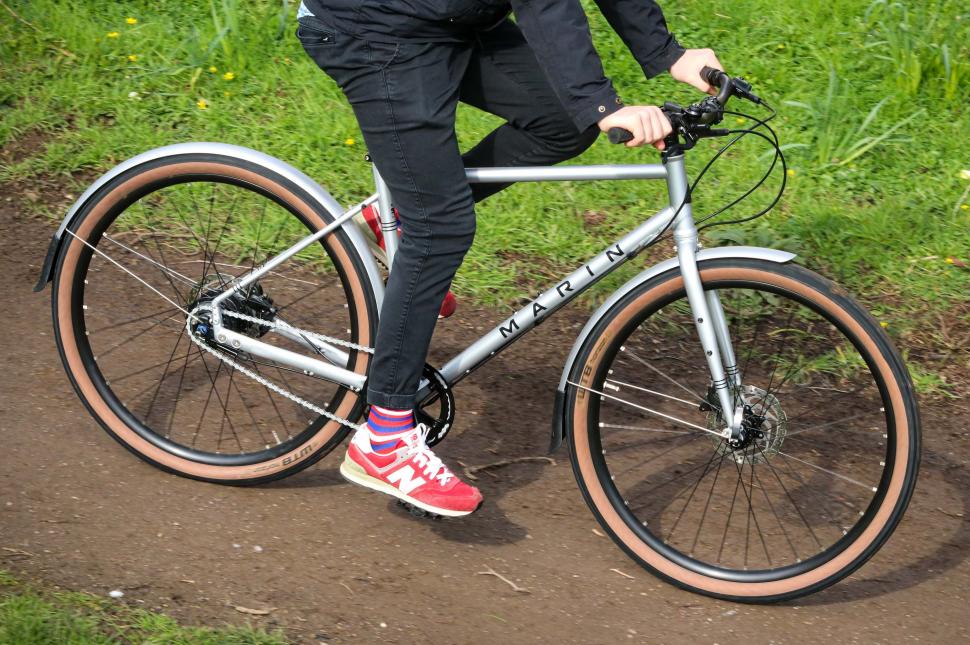


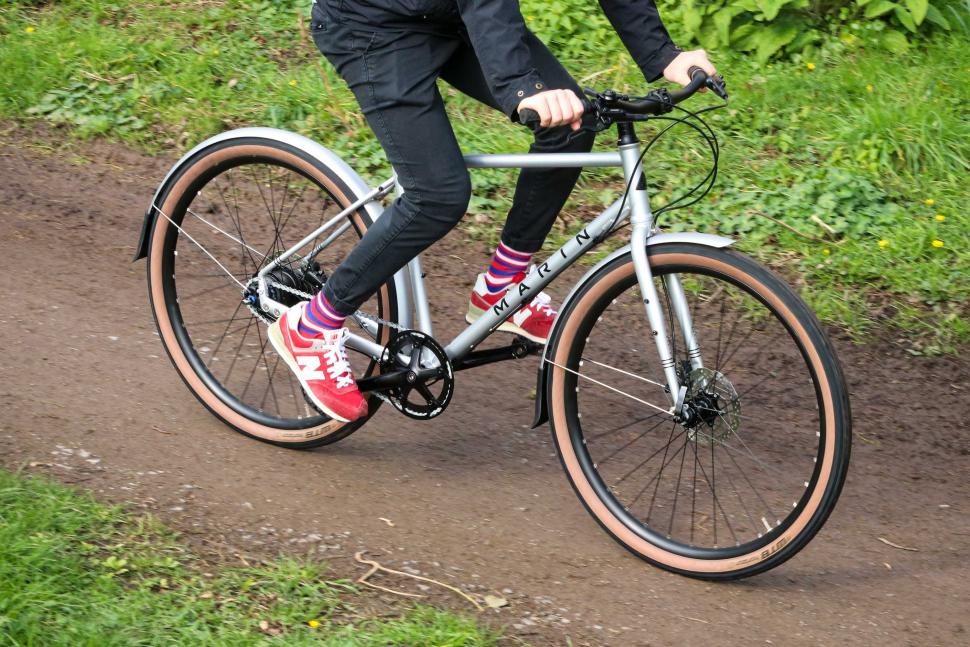



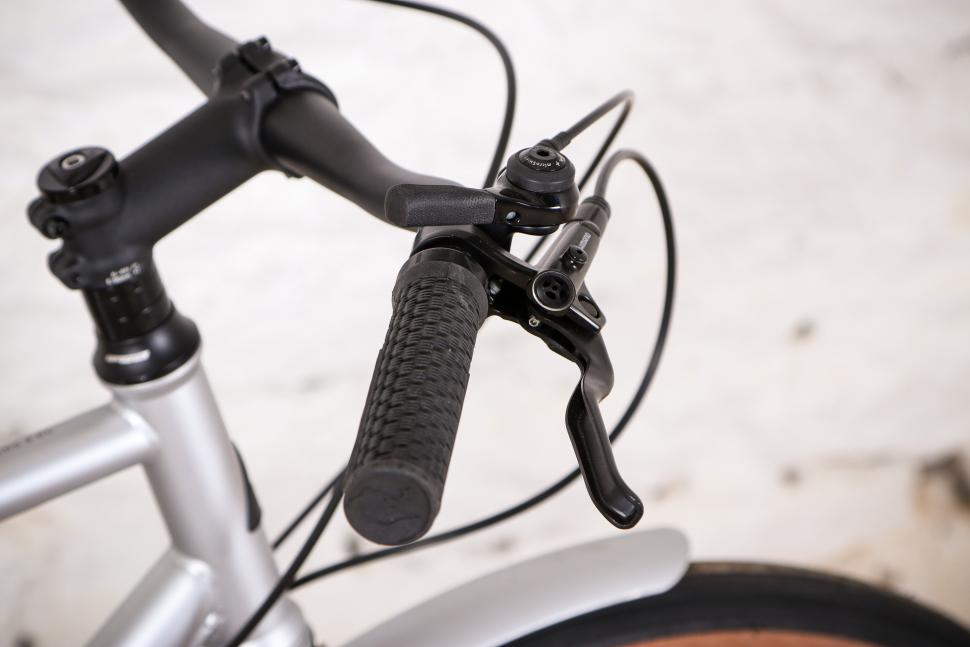


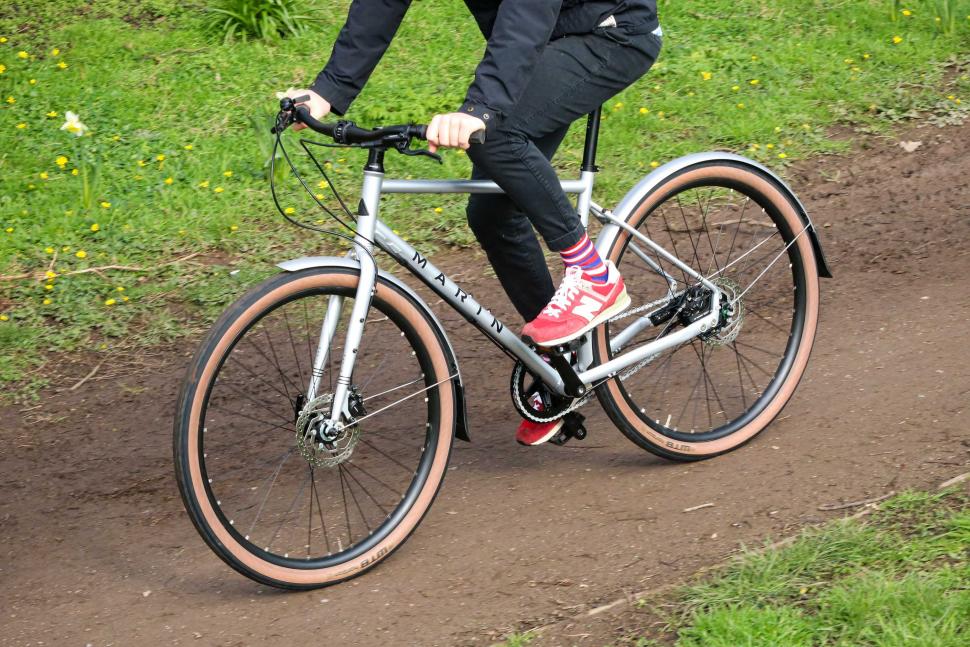





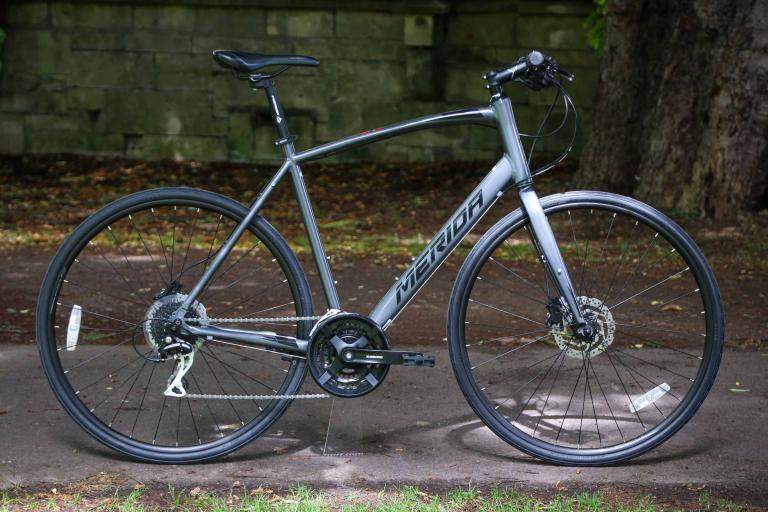
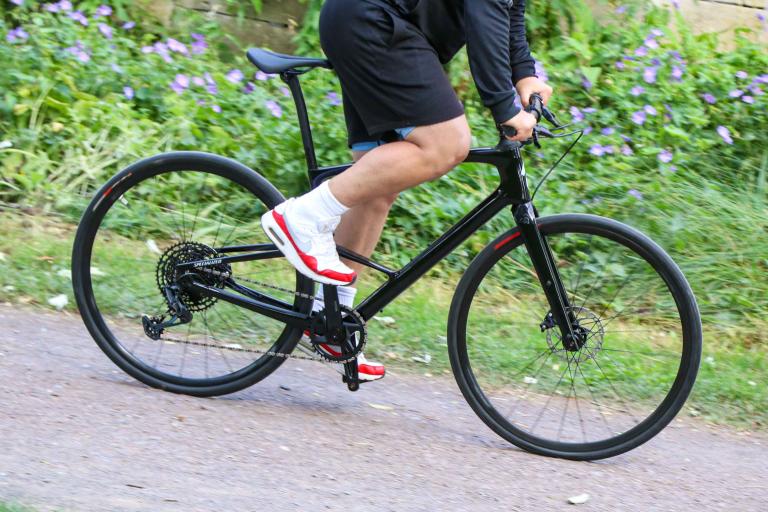
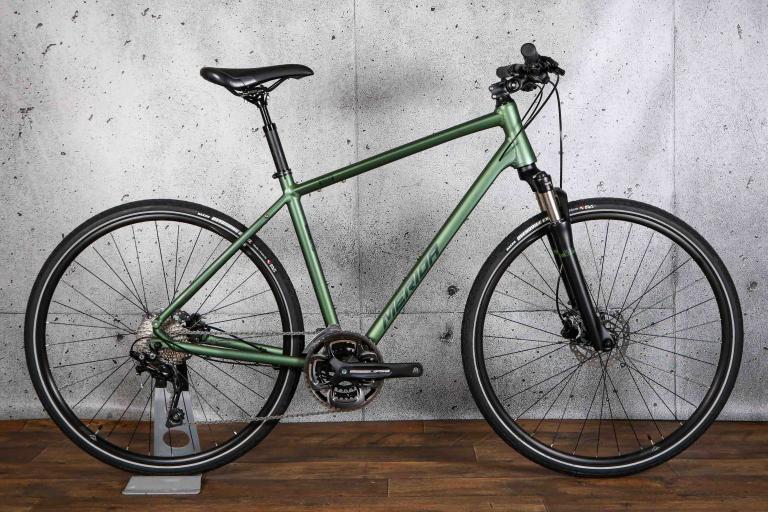
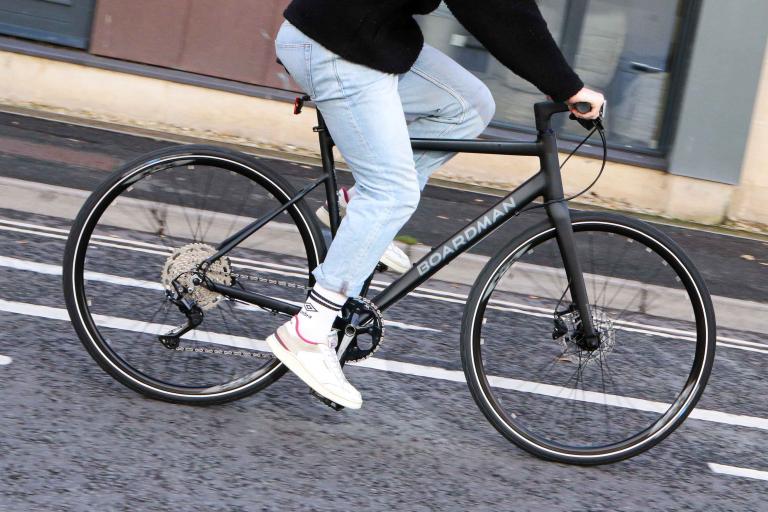
Add new comment
6 comments
I think the bike was just too small, and the reviewer needed a longer top tube or stem.
I had backswept bars on a very similar bike, Raleigh Redux, and had no trouble sprinting.
Also, saying the bike should have a carbon belt and rohloff is pretty silly considering it would triple the cost of the bike.
I don't own the bike and haven't ridden it, but it looks interesting. It just seems like the reviewer was reviewing it from his own narrow perspective rather than whom it's intended for ( eg mid price commuter, heavier but low maintenance drive train, etc)
I'm not normally keen to get involved in discussions in the comments section but I think it's worth making an exception in this case.
The only 'narrow perspective' I had was: 'Is this a good bike?'
I'm always surprised that people think commuters who are prepared to pay almost £1,000 (is that really 'mid-priced commuter'? It was at the very top end of the previous cycle-to-work scheme allowance) should be happy to make do with an uninspiring 14kg machine. My opinion is that somebody who is planning to use their bike as everyday transport deserves the best ride experience just as much as riders who use their bike for sporting purposes.
For the record, I didn't say the bike should have a Gates Carbon Drive belt AND Rohloff hub. I said in the main review that the bike should have a Gates Carbon Drive belt - I stand by that. If you're making a low-maintenance bike, why would you not fit one? Marin itself makes the Presidio 3 with a Nexus hub and Gates belt for £895 - https://www.marinbikes.com/gb/bikes/20-presidio-3 - so it can be done without requiring a massive premium.
I then said separately in the Test Report that it would be worth spending more to buy a bike with an Alfine OR Rohloff hub. You can buy bikes with an Alfine hub - and, incidentally a Gates Carbon Drive belt - such as the Cube Travel Exc, for £1,199. https://www.cube.eu/en/2020/bikes/tour/travel/cube-travel-exc-iridiumnbl...
£1,199 is not three times £985.
Look, it would be easier for all of us if we just said every bike was 'fine' and gave it 7 or 8 out of 10. Thankfully, most modern bikes really are pretty good. But some aren't, and in cases like this, I'd like to make sure - even if you like the look of the bike - you then at least do your own test ride before buying. If you really think I'm wrong and you really want one, go and test ride it and make up your own mind.
Finally, let me say this: more than a decade ago Isla Rowntree realised children deserved lighter and better bikes then they were getting. I personally think adult commuters, leisure riders and people new to cycling often deserve better bikes, too - not least when they're paying £1,000!
Fair points, I'm a yank and hadn't realized how pricey it was there. It's 745 gbp in the US; we also don't get Cube bikes here.
As for weight, I don't think it's all that heavy given the design choices, principally fenders, Igh, and wider tires. The Jamie Sequel S1 costs 50% more stateside, weighs 12.7 kg, and has a derailleur instead of an IGH. But you're right about having a belt and/or Alfine at those prices. Priority Bikes sells belt drive bikes at very modest prices, albeit direct to consumer.
That odd handling sounds like a problem with fork offset and trail rather than the handlebars.
I have an old Ridgeback with almost exactly the same specs and curvy handlebars and it's a blast to ride, but its lighter, with an alloy frame, so I think that this is a frame and fork problem which is a real shame as an Alfine/Nexus hub is a great asset for commuting. Mine is geared 46/18 which is about right for London, but I'm on 26 x 1.6" wheels/tyres.
A good excuse to be late for work!
Thanks for the honest review.
Gearing does seem a little tall, especially for a relaxed position cruise-muter with only 8 ratios. Swapping out the 19T rear cog for a 22T would get the low gear to ~ 1:1, and still have enough top end to hit 20mph at a moderate ~82rpm cadence.